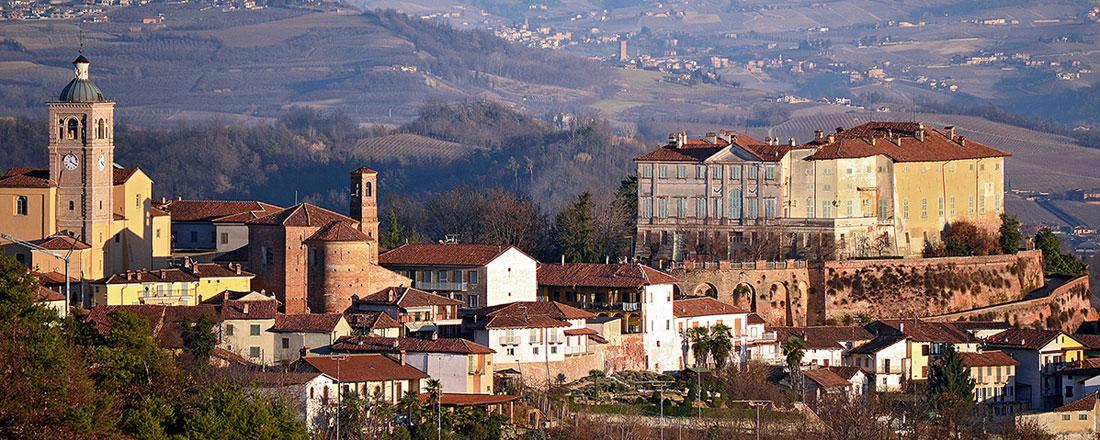SOMMARIVA PERNO
Sommariva Perno is one of the eight towns located on the top of the Rocche that has a huge calling for the outdoors: the Roero Forest Park, located in its territory, it’s the proof. The town is characterized by a concentric (village) that, grouped around the Mirafiori Castle and around the parish churches and the San Bernardino’s church, degrades towards the plateau in direction of Turin, where the landscape conformation changes, leaving a large space for the “silva popularis” woods.
HISTORIC BACKGROUND
The territory of Sommariva gets a lot of interest in the Roman age thanks to a strata that connected Alba to the Po plain. Some settlements formed along the way: one of this, Paernum, is remembered in the current ephitet. In the Medieval Age a village started to form on the edge of the hill (ad summam ripae), which gave the name to the town over time. The domains de Summaripa, quoted since 1164, achieve a prominent role in the entire area thanks to the strategic position of their possessions. In 1282 the Isnarni appeared, to whom the city of Asti assigned a fief as a share together with the castle. Later on, in 1313, Sommariva was assigned to Filippo d’Acaja. At the end of the 1300 the Roero family started to be part of the lordship of Sommariva too, who, at the beginning of the 1600, would own, with Conreno Roero, the whole fief. After his death in 1623, Carlo Emanuele I di Savoia takes over, who is going to be the one to upgrade the fief in Marquisate. In the 1800s Vittorio Emanuele II purchases the castle and the possessions in order to donate them to Rosa Vercellana (la bela Rosin), countess of Mirafiori and morganatic wife of the King.
MUST SEE:
CASTLE (private). It’s been quoted since the 1153, when the pope Eugenio III feudalized it under the powerful “domini de Summaripa”. After being in the Isnardi’s possession for a long time and then going under Cornero Roero’s property, the castle gradually lost its quality of fortress to assume the one of noble residence. Renovated and enlarged by the Carron family of St. Thomas, who purchased it from Don Felice di Savoia, was obtained by King Vittorio Emanuele II in 1857, who transformed it in a hunting lodge and residence of the morganatic wife Rosa Vercellana, countess of Mirafiori, commonly known as the “Bela Rosin”. It’s currently property of the earls Gromis of Trana and it’s not open to the public.
VITTORIO EMANUELE II ARCH. It’s the door to enter the old town, from south-west. The crenellated neogothic building is considered a proof of the “big war” that hit Sommariva Perno in 1800s. It actually shows the commemorative plaque with which the inhabitants of Sommariva wanted to thank Vittorio Emanuele II, the “King gentleman”, in 1888, who, starting from this corner of the Roero for the Third War of Independence, exclaimed: “Qui faro’ ritorno quando avro’ reso l’Italia indipendente ed una”, which means: “I will come back here once I will make Italy independent and as one”.
HOLY SPIRIT PARISH CHURCH. It is situated in the old town and was built between the 1669 and the 1675. The façade is completely frescoed with a “trompe d’oeuil” effect; it preserves several seventeenth century artistic testimonies and a splendid wooden choir, precious stuccos from 1780-82, an original Via Crucis and an interesting cycle of baroque frescoes.
SAN BERNARDINO CONFRATERNITY. House of the Disciplinanti Confraternity, it was built in baroque shapes in 1768, with an octagonal base and with a vaulted frescoed ceiling. It’s been totally renovated by the the Municipality in 1995 and today it’s designated as a Cultural Centre. Inside there are two canvas by the Bra native painter Pietro Paolo Operti.
SAN GIUSEPPE PARISH CHURCH. The date of construction is unknown; in 1742 the church was quoted in a report for a pastoral visit. In the 1748 the building was partly renovated and extended. In 2000 it was the subject of an important intervention to recover the original frescoes and the one on the façade.
VALLE ROSSI’S CHURCH. It’s located in the middle of the Valle Rossi village and it contains a masterpiece of the piedmontese art: the “Pieta’” by Martino Spanzotti (1456-1528), the most popular and precious “piece” that’s been recently renovated, and with its sober and rigorous shapes, still preserves the charm and the mystery that have always characterized this place of profound religiousness over the centuries.





